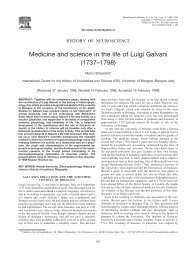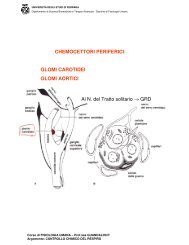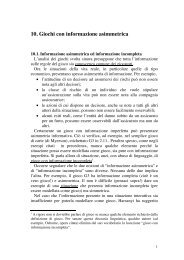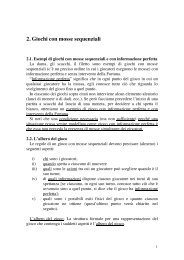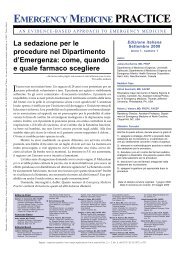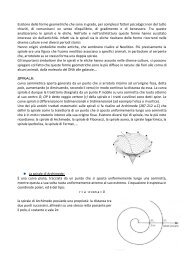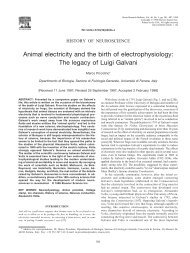Print: Inhalational Anesthetics - utenti
Print: Inhalational Anesthetics - utenti
Print: Inhalational Anesthetics - utenti
Create successful ePaper yourself
Turn your PDF publications into a flip-book with our unique Google optimized e-Paper software.
<strong>Print</strong>: <strong>Inhalational</strong> <strong>Anesthetics</strong><br />
Note: Large images and tables on this page may necessitate printing in landscape mode.<br />
Copyright ©2004 - 2005 The McGraw-Hill Companies. All rights reserved.<br />
<strong>Print</strong> Close Window<br />
Goodman & Gilman's PHARMACOLOGY, 10e > Section III. Drugs Acting on the Central Nervous<br />
System > Chapter 14. General <strong>Anesthetics</strong> ><br />
<strong>Inhalational</strong> <strong>Anesthetics</strong><br />
Introduction<br />
A wide variety of gases and volatile liquids can produce anesthesia. The first widely<br />
used inhalational anesthetic was diethyl ether (see Chapter 13: History and Principles<br />
of Anesthesiology). Subsequently, a variety of structurally unrelated compounds have<br />
been used as inhalational anesthetics including cyclopropane, elemental xenon, nitrous<br />
oxide, and more recently, short-chain halogenated alkanes and ethers. The structures<br />
of the currently used inhalational anesthetics are shown in Figure 14–4. One of the<br />
troublesome properties of the inhalational anesthetics is their low safety margin. The<br />
inhalational anesthetics have therapeutic indices (LD 50 /ED 50 ) that range from 2 to 4,<br />
making these among the most dangerous drugs in clinical use. The toxicity of these<br />
drugs is largely a function of their side effects, and each of the inhalational anesthetics<br />
has a unique side-effect profile. Hence, the selection of an inhalational anesthetic often<br />
is based on matching a patient's pathophysiology with drug side-effect profiles. The<br />
specific adverse effects of each of the inhalational anesthetics are emphasized in the<br />
following sections. The inhalational anesthetics also vary widely in their physical<br />
properties. Table 14–1 lists the important physical properties of the inhalational agents<br />
in clinical use. These properties are important because they govern the<br />
pharmacokinetics of the inhalational agents. Ideally, an inhalational agent would<br />
produce a rapid induction of anesthesia and a rapid recovery following discontinuation.<br />
The pharmacokinetics of the inhalational agents is reviewed in the following section.<br />
Figure 14–4. Structures of <strong>Inhalational</strong> General <strong>Anesthetics</strong>.<br />
http://www.accessmedicine.com/popup.aspx?aID=414198&print=yes (1 di 23)08/07/2005 16.38.06
<strong>Print</strong>: <strong>Inhalational</strong> <strong>Anesthetics</strong><br />
Note that all inhalational general anesthetic agents except nitrous oxide and halothane are<br />
ethers and that fluorine progressively replaces other halogens in the development of the<br />
halogenated agents. All structural differences are associated with important differences in<br />
pharmacological properties.<br />
Pharmacokinetic Principles<br />
The inhalational agents are some of the very few pharmacological agents administered<br />
as gases. The fact that these agents behave as gases rather than as liquids requires<br />
that different pharmacokinetic constructs be used in analyzing their uptake and<br />
distribution. It is essential to understand that inhalational anesthetics distribute<br />
between tissues (or between blood and gas) such that equilibrium is achieved when the<br />
partial pressure of anesthetic gas is equal in the two tissues. When a person has<br />
breathed an inhalational anesthetic for a sufficiently long time that all tissues are<br />
equilibrated with the anesthetic, the partial pressure of the anesthetic in all tissues will<br />
be equal to the partial pressure of the anesthetic in inspired gas. It is important to note<br />
that while the partial pressure of the anesthetic may be equal in all tissues, the<br />
concentration of anesthetic in each tissue will be different. Indeed, anesthetic partition<br />
coefficients are defined as the ratio of anesthetic concentration in two tissues when the<br />
http://www.accessmedicine.com/popup.aspx?aID=414198&print=yes (2 di 23)08/07/2005 16.38.06
<strong>Print</strong>: <strong>Inhalational</strong> <strong>Anesthetics</strong><br />
partial pressures of anesthetic are equal in the two tissues. Blood:gas, brain:blood, and<br />
blood:fat partition coefficients for the various inhalational agents are listed in Table 14–<br />
1. These partition coefficients show that inhalational anesthetics are more soluble in<br />
some tissues (e.g., fat) than they are in other (e.g., blood), and that there is<br />
significant range in the solubility of the various inhalational agents in such tissues.<br />
In clinical practice, one can monitor the equilibration of a patient with anesthetic gas.<br />
Equilibrium is achieved when the partial pressure in inspired gas is equal to the partial<br />
pressure in end-tidal (alveolar) gas. This defines equilibrium, because it is the point<br />
when there is no net uptake of anesthetic from the alveoli into the blood. For<br />
inhalational agents that are not very soluble in blood or any other tissue, equilibrium is<br />
achieved quickly, as illustrated for nitrous oxide in Figure 14–5. If an agent is more<br />
soluble in a tissue such as fat, equilibrium may take many hours to reach. This occurs<br />
because fat represents a huge reservoir for the anesthetic, which will be filled slowly<br />
because of the modest blood flow to fat. This is illustrated by the slow approach of<br />
halothane alveolar partial pressure to inspired partial pressure in Figure 14–5.<br />
Figure 14–5. Uptake of <strong>Inhalational</strong> General <strong>Anesthetics</strong>.<br />
http://www.accessmedicine.com/popup.aspx?aID=414198&print=yes (3 di 23)08/07/2005 16.38.06
<strong>Print</strong>: <strong>Inhalational</strong> <strong>Anesthetics</strong><br />
The rise in alveolar (F A ) anesthetic concentration toward the inspired (F I ) concentration is<br />
most rapid with the least soluble anesthetics, nitrous oxide and desflurane, and slowest with<br />
the most soluble anesthetic, halothane. All data are from human studies. (Reproduced with<br />
permission from Eger, 2000.)<br />
In considering the pharmacokinetics of anesthetics, one important parameter is the<br />
speed of anesthetic induction. Anesthetic induction requires that brain partial pressure<br />
be equal to MAC. Because the brain is well perfused, anesthetic partial pressure in<br />
brain becomes equal to the partial pressure in alveolar gas (and in blood) over the<br />
course of several minutes. Therefore, anesthesia is achieved shortly after alveolar<br />
partial pressure reaches MAC. While the rate of rise of alveolar partial pressure will be<br />
slower for anesthetics that are highly soluble in blood and other tissues, this limitation<br />
on speed of induction can be overcome largely by delivering higher inspired partial<br />
pressures of the anesthetic.<br />
Elimination of inhalational anesthetics is largely the reverse process of uptake. For<br />
agents with low blood and tissue solubility, recovery from anesthesia should mirror<br />
anesthetic induction, regardless of the duration of anesthetic administration. For<br />
inhalational agents with high blood and tissue solubility, recovery will be a function of<br />
the duration of anesthetic administration. This occurs because the accumulated<br />
amounts of anesthetic in the fat reservoir will prevent blood (and therefore alveolar)<br />
partial pressures from falling rapidly. Patients will be arousable when alveolar partial<br />
pressure reaches MAC awake , a partial pressure somewhat lower than MAC (see Table<br />
14–1).<br />
Halothane<br />
Chemistry and Formulation<br />
Halothane (FLUOTHANE) is 2-bromo-2-chloro-1,1,1-trifluoroethane (see Figure 14–4).<br />
Halothane is a volatile liquid at room temperature and must be stored in a sealed<br />
container. Because halothane is a light-sensitive compound that also is subject to<br />
spontaneous breakdown, it is marketed in amber bottles with thymol added as a<br />
preservative. Mixtures of halothane with oxygen or air are neither flammable nor<br />
explosive.<br />
Pharmacokinetic<br />
Halothane has a relatively high blood:gas partition coefficient and high blood:fat<br />
http://www.accessmedicine.com/popup.aspx?aID=414198&print=yes (4 di 23)08/07/2005 16.38.06
<strong>Print</strong>: <strong>Inhalational</strong> <strong>Anesthetics</strong><br />
partition coefficient (see Table 14–1). Induction with halothane therefore is relatively<br />
slow, and the alveolar halothane concentration remains substantially lower than the<br />
inspired halothane concentration for many hours of administration. Because halothane<br />
is soluble in fat and other body tissues, it will accumulate during prolonged<br />
administration. Therefore, the speed of recovery from halothane is lengthened as a<br />
function of duration of administration (Stoelting and Eger, 1969).<br />
Approximately 60% to 80% of halothane taken up by the body is eliminated<br />
unchanged via the lungs in the first 24 hours after its administration. A substantial<br />
amount of the halothane not eliminated in exhaled gas is biotransformed in the liver by<br />
cytochrome P450 enzymes. The major metabolite of halothane is trifluoroacetic acid,<br />
which is formed by removal of bromine and chlorine ions (Gruenke et al., 1988).<br />
Trifluoroacetic acid, bromine, and chlorine all can be detected in the urine.<br />
Trifluoroacetylchloride, an intermediate in oxidative metabolism of halothane, can<br />
trifluoroacetylate covalently several proteins in the liver. An immune reaction to these<br />
altered proteins may be responsible for the rare cases of fulminant halothane-induced<br />
hepatic necrosis (Kenna et al., 1988). There also is a minor reductive pathway<br />
accounting for approximately 1% of halothane metabolism and generally observed only<br />
under hypoxic conditions (Van Dyke et al., 1988).<br />
Clinical Use<br />
Halothane, introduced in 1956, was the first of the modern, halogenated inhalational<br />
anesthetics used in clinical practice. It is a potent agent that usually is used for<br />
maintenance of anesthesia. It is not pungent and is therefore well tolerated for<br />
inhalation induction of anesthesia. This is most commonly done in children, where<br />
preoperative placement of an intravenous catheter can be difficult. Anesthesia is<br />
produced by halothane at end-tidal concentrations of 0.7% to 1.0% halothane. The<br />
end-tidal concentration of halothane required to produce anesthesia is substantially<br />
reduced when it is coadministered with nitrous oxide. The use of halothane in the<br />
United States has diminished substantially in the past decade because of the<br />
introduction of newer inhalational agents with better pharmacokinetic and side-effect<br />
profiles. Halothane continues to be extensively used in children because it is well<br />
tolerated for inhalation induction and because the serious side effects appear to be<br />
diminished in children. Halothane has a low cost and is therefore still widely used in<br />
developing countries.<br />
http://www.accessmedicine.com/popup.aspx?aID=414198&print=yes (5 di 23)08/07/2005 16.38.06
<strong>Print</strong>: <strong>Inhalational</strong> <strong>Anesthetics</strong><br />
Side Effects<br />
Cardiovascular System<br />
The most predictable side effect of halothane is a dose-dependent reduction in arterial<br />
blood pressure. Mean arterial pressure decreases about 20% to 25% at MAC<br />
concentrations of halothane. This reduction in blood pressure primarily is the result of<br />
direct myocardial depression leading to reduced cardiac output (see Figure 14–6).<br />
Myocardial depression is thought to result from attenuation of depolarization-induced<br />
intracellular calcium transients (Lynch, 1997). Halothane-induced hypotension usually<br />
is accompanied by either bradycardia or a normal heart rate. This absence of a<br />
tachycardic (or contractile) response to reduced blood pressure is thought to be due to<br />
an inability of the heart to respond to the effector arm of the baroceptor reflex. Heart<br />
rate can be increased during halothane anesthesia by exogenous catecholamine or by<br />
sympathoadrenal stimulation. Halothane-induced reductions in blood pressure and<br />
heart rate generally disappear after several hours of constant halothane<br />
administration. This is thought to occur because of progressive sympathetic stimulation<br />
(Eger et al., 1970).<br />
Figure 14–6. Influence of <strong>Inhalational</strong> General <strong>Anesthetics</strong> on the<br />
Systemic Circulation.<br />
http://www.accessmedicine.com/popup.aspx?aID=414198&print=yes (6 di 23)08/07/2005 16.38.06
<strong>Print</strong>: <strong>Inhalational</strong> <strong>Anesthetics</strong><br />
While all of the inhalational anesthetics reduce systemic blood pressure in a dose-related<br />
manner (top), the lower figure shows that cardiac output is well preserved with isoflurane<br />
and desflurane and, therefore, that the causes of hypotension vary with the agent. (Data are<br />
from human studies except for sevoflurane, where data are from swine: Bahlman et al.,<br />
1972; Cromwell et al., 1971; Weiskopf et al., 1991; Calverley et al., 1978; Stevens et al.,<br />
1971; Eger et al., 1970; Weiskopf et al., 1988).<br />
Halothane does not cause a significant change in systemic vascular resistance.<br />
Nonetheless, it causes changes in the resistance and autoregulation of specific vascular<br />
beds leading to redistribution of blood flow. The vascular beds of the skin and brain are<br />
http://www.accessmedicine.com/popup.aspx?aID=414198&print=yes (7 di 23)08/07/2005 16.38.06
<strong>Print</strong>: <strong>Inhalational</strong> <strong>Anesthetics</strong><br />
dilated directly by halothane, leading to increased cerebral blood flow and skin<br />
perfusion. Conversely, autoregulation of renal, splanchnic, and cerebral blood flow is<br />
inhibited by halothane, leading to reduced perfusion of these organs in the face of<br />
reduced blood pressure. Coronary autoregulation is largely preserved during halothane<br />
anesthesia. Finally, halothane does inhibit hypoxic pulmonary vasoconstriction, which<br />
leads to increased perfusion to poorly ventilated regions of the lung and an increased<br />
alveolar:arterial oxygen gradient.<br />
Halothane also has significant effects on cardiac rhythm. Sinus bradycardia and<br />
atrioventricular rhythms occur frequently during halothane anesthesia but are usually<br />
benign. These rhythms result mainly from a direct depressive effect of halothane on<br />
sinoatrial node discharge. Halothane also can sensitize the myocardium to the<br />
arrythmogenic effects of epinephrine (Sumikawa et al., 1983). Premature ventricular<br />
contractions and sustained ventricular tachycardia can be observed during halothane<br />
anesthesia when exogenous administration or endogenous adrenal production elevates<br />
plasma epinephrine levels. Epinephrine-induced arrhythmias during halothane<br />
anesthesia are thought to be mediated by a synergistic effect on 1 - and 1 -adrenergic<br />
receptors (Hayashi et al., 1988).<br />
Respiratory System<br />
Spontaneous respiration is rapid and shallow during halothane anesthesia. This<br />
produces a decrease in alveolar ventilation resulting in an elevation in arterial carbon<br />
dioxide tension from 40 mm Hg to >50 mm Hg at 1 MAC (see Figure 14–7). The<br />
elevated carbon dioxide does not provoke a compensatory increase in ventilation,<br />
because halothane causes a concentration-dependent inhibition of the ventilatory<br />
response to carbon dioxide (Knill and Gelb, 1978). This action of halothane is thought<br />
to be mediated by depression of central chemoceptor mechanisms. Halothane also<br />
inhibits peripheral chemoceptor responses to arterial hypoxemia. Thus, neither<br />
hemodynamic (tachycardia, hypertension) nor ventilatory responses to hypoxemia are<br />
observed during halothane anesthesia, making it prudent to monitor arterial<br />
oxygenation directly. Halothane also is an effective bronchodilator, producing direct<br />
relaxation of bronchial smooth muscle (Yamakage, 1992) and has been effectively used<br />
as a treatment of last resort in patients with status asthmaticus (Gold and Helrich,<br />
1970).<br />
http://www.accessmedicine.com/popup.aspx?aID=414198&print=yes (8 di 23)08/07/2005 16.38.06
<strong>Print</strong>: <strong>Inhalational</strong> <strong>Anesthetics</strong><br />
Figure 14–7. Respiratory Effects of <strong>Inhalational</strong> <strong>Anesthetics</strong>.<br />
Spontaneous ventilation with all of the halogenated inhalational anesthetics reduces minute<br />
volume of ventilation in a dose-dependent manner (lower panel). This results in an increased<br />
arterial carbon dioxide tension (top panel). Differences among agents are modest. (Data are<br />
from Doi and Ikeda, 1987; Lockhart et al., 1991; Munson et al., 1966; Calverley et al., 1978;<br />
Fourcade et al., 1971.)<br />
Nervous System<br />
Halothane dilates the cerebral vasculature, increasing cerebral blood flow under most<br />
conditions. This increase in blood flow can increase intracranial pressure in patients<br />
with space-occupying intracranial masses, brain edema, or preexisting intracranial<br />
http://www.accessmedicine.com/popup.aspx?aID=414198&print=yes (9 di 23)08/07/2005 16.38.06
<strong>Print</strong>: <strong>Inhalational</strong> <strong>Anesthetics</strong><br />
hypertension. For this reason, halothane is relatively contraindicated in patients at risk<br />
for elevated intracranial pressure. Halothane also attenuates autoregulation of cerebral<br />
blood flow. For this reason, cerebral blood flow can decrease when arterial blood<br />
pressure is markedly decreased. Modest decreases in cerebral blood flow generally are<br />
well tolerated, because halothane also reduces cerebral metabolic consumption of<br />
oxygen.<br />
Muscle<br />
Halothane causes some relaxation of skeletal muscle via its central-depressant effects.<br />
Halothane also potentiates the actions of nondepolarizing muscle relaxants (curariform<br />
drugs; see Chapter 9: Agents Acting at the Neuromuscular Junction and Autonomic<br />
Ganglia), increasing both their duration of action and the magnitude of their effect.<br />
Halothane also is one of the triggering agents for malignant hyperthermia, a syndrome<br />
characterized by severe muscle contraction, rapid development of hyperthermia, and a<br />
massive increase in metabolic rate in genetically susceptible patients. This syndrome<br />
frequently is fatal and is treated by immediate discontinuation of the anesthetic and<br />
administration of dantrolene.<br />
Uterine smooth muscle is relaxed by halothane. This is a useful property for<br />
manipulation of the fetus (version) in the prenatal period and for delivery of retained<br />
placenta postnatally. Halothane, however, does inhibit uterine contractions during<br />
parturition, prolonging labor and increasing blood loss. Halothane therefore is not used<br />
as an analgesic or anesthetic for labor and vaginal delivery.<br />
Kidney<br />
Patients anesthetized with halothane usually produce a small volume of concentrated<br />
urine. This is the consequence of halothane-induced reduction of renal blood flow and<br />
glomerular filtration rate; these parameters may be reduced by 40% to 50% at 1 MAC.<br />
(Mazze et al., 1963). Halothane-induced changes in renal function are fully reversible<br />
and are not associated with long-term nephrotoxicity.<br />
Liver and Gastrointestinal Tract<br />
Halothane reduces splanchnic and hepatic blood flow as a consequence of reduced<br />
perfusion pressure, as discussed above. This reduced blood flow has not been shown to<br />
produce detrimental effects on hepatic or gastrointestinal function.<br />
Halothane can produce fulminant hepatic necrosis in a small number of patients. This<br />
http://www.accessmedicine.com/popup.aspx?aID=414198&print=yes (10 di 23)08/07/2005 16.38.06
<strong>Print</strong>: <strong>Inhalational</strong> <strong>Anesthetics</strong><br />
syndrome generally is characterized by fever, anorexia, nausea, and vomiting<br />
developing several days after anesthesia and can be accompanied by a rash and<br />
peripheral eosinophilia. There is a rapid progression to hepatic failure, with a fatality<br />
rate of approximately 50%. This syndrome occurs in about 1 in 10,000 patients<br />
receiving halothane and is referred to as halothane hepatitis (Subcommittee on the<br />
National Halothane Study, 1966). Current thinking is that halothane hepatitis is the<br />
result of an immune response to trifluoracetylated proteins on hepatocytes<br />
(see"Pharmacokinetics," above).<br />
Isoflurane<br />
Chemistry and Physical Properties<br />
Isoflurane (FORANE) is 1-chloro-2,2,2-trifluoroethyl difluoromethyl ether (see Figure 14–<br />
4). It is a volatile liquid at room temperature and is neither flammable nor explosive in<br />
mixtures of air or oxygen.<br />
Pharmacokinetics<br />
Isoflurane has a blood:gas partition coefficient substantially lower than that of<br />
halothane or enflurane (see Table 14–1). Consequently, induction with isoflurane and<br />
recovery from isoflurane are relatively rapid. Changes in anesthetic depth also can be<br />
achieved more rapidly with isoflurane than with halothane or enflurane. More than 99%<br />
of inhaled isoflurane is excreted unchanged via the lungs. Approximately 0.2% of<br />
absorbed isoflurane is oxidatively metabolized by cytochrome P450 2E1 (Kharasch et<br />
al., 1993). The small amount of isoflurane degradation products produced are<br />
insufficient to produce any renal, hepatic, or other organ toxicity. Isoflurane does not<br />
appear to be a mutagen, teratogen, or carcinogen (Eger et al., 1978).<br />
Clinical Use<br />
Isoflurane is the most commonly used inhalational anesthetic in the United States.<br />
Induction of anesthesia can be achieved in less than 10 minutes with an inhaled<br />
concentration of 3% isoflurane in oxygen; this concentration is reduced to 1.5% to<br />
2.5% for maintenance of anesthesia. The use of other drugs such as opioids or nitrous<br />
oxide reduces the concentration of isoflurane required for surgical anesthesia.<br />
Side Effects<br />
Cardiovascular System<br />
http://www.accessmedicine.com/popup.aspx?aID=414198&print=yes (11 di 23)08/07/2005 16.38.06
<strong>Print</strong>: <strong>Inhalational</strong> <strong>Anesthetics</strong><br />
Isoflurane produces a concentration-dependent decrease in arterial blood pressure.<br />
Unlike halothane, cardiac output is well maintained with isoflurane, and hypotension is<br />
the result of decreased systemic vascular resistance (see Figure 14–6). Isoflurane<br />
produces vasodilation in most vascular beds, with particularly pronounced effects in<br />
skin and muscle. Isoflurane is a potent coronary vasodilator, simultaneously producing<br />
increased coronary blood flow and decreased myocardial oxygen consumption. In<br />
theory, this makes isoflurane a particularly safe anesthetic to use for patients with<br />
ischemic heart disease. However, concern has been raised that isoflurane may produce<br />
myocardial ischemia by inducing "coronary steal" (i.e., the diversion of blood flow from<br />
poorly perfused to well-perfused areas) (Buffington et al., 1988). This concern has not<br />
been substantiated in subsequent animal and human studies. Patients anesthetized<br />
with isoflurane generally have mildly elevated heart rates, and rapid changes in<br />
isoflurane concentration can produce transient tachycardia and hypertension. This is<br />
the result of direct isoflurane-induced sympathetic stimulation.<br />
Respiratory System<br />
Isoflurane produces concentration-dependent depression of ventilation. Patients<br />
spontaneously breathing isoflurane have a normal rate of respiration but a reduced<br />
tidal volume, resulting in a marked reduction in alveolar ventilation and an increase in<br />
arterial carbon dioxide tension (see Figure 14–7). Isoflurane is particularly effective at<br />
depressing the ventilatory response to hypercapnia and hypoxia (Hirshman et al.,<br />
1977). While isoflurane is an effective bronchodilator, it also is an airway irritant and<br />
can stimulate airway reflexes during induction of anesthesia, producing coughing and<br />
laryngospasm.<br />
Nervous System<br />
Isoflurane, like halothane, dilates the cerebral vasculature, producing increased<br />
cerebral blood flow and the risk of increased intracranial pressure. Isoflurane also<br />
reduces cerebral metabolic oxygen consumption. Isoflurane causes less cerebral<br />
vasodilation than do either enflurane or halothane, making it a preferred agent for<br />
neurosurgical procedures (Drummond et al., 1983). The modest effects of isoflurane on<br />
cerebral blood flow can be reversed readily by hyperventilation (McPherson et al.,<br />
1989).<br />
Muscle<br />
http://www.accessmedicine.com/popup.aspx?aID=414198&print=yes (12 di 23)08/07/2005 16.38.06
<strong>Print</strong>: <strong>Inhalational</strong> <strong>Anesthetics</strong><br />
Isoflurane produces some relaxation of skeletal muscle via its central effects. It also<br />
enhances the effects of both depolarizing and nondepolarizing muscle relaxants.<br />
Isoflurane is more potent than halothane in its potentiation of neuromuscular blocking<br />
agents. Isoflurane, like other halogenated inhalational anesthetics, relaxes uterine<br />
smooth muscle and is not recommended for analgesia or anesthesia for labor and<br />
vaginal delivery.<br />
Kidney<br />
Isoflurane reduces renal blood flow and glomerular filtration rate. This results in a<br />
small volume of concentrated urine. Changes in renal function observed during<br />
isoflurane anesthesia are rapidly reversed, and there are no long-term renal sequelae<br />
or toxicity associated with isoflurane.<br />
Liver and Gastrointestinal Tract<br />
Splanchnic (and hepatic) blood flow is reduced with increasing doses of isoflurane, as<br />
systemic arterial pressure decreases. Liver function tests are minimally affected by<br />
isoflurane, and there is no described incidence of hepatic toxicity with isoflurane.<br />
Enflurane<br />
Chemical and Physical Properties<br />
Enflurane (ETHRANE) is 2-chloro-1,1,2-trifluoroethyl difluoromethyl ether (see Figure 14–<br />
4). It is a clear colorless liquid at room temperature with a mild, sweet odor. Like other<br />
inhalational anesthetics, it is volatile and must be stored in a sealed bottle. It is<br />
nonflammable and nonexplosive in mixtures of air or oxygen.<br />
Pharmacokinetics<br />
Because of its relatively high blood:gas partition coefficient, induction of anesthesia<br />
and recovery from enflurane are relatively slow (see Table 14–1). Enflurane is<br />
metabolized to a modest extent, with 2% to 8% of absorbed enflurane undergoing<br />
oxidative metabolism in the liver by cytochrome P450 2E1 (Kharasch et al., 1994).<br />
Fluoride ions are a by-product of enflurane metabolism, but plasma fluoride levels are<br />
low and nontoxic. Patients taking isoniazid exhibit enhanced metabolism of enflurane<br />
with significantly elevated serum fluoride concentrations (Mazze et al., 1982).<br />
Clinical Use<br />
Surgical anesthesia can be induced with enflurane in less than 10 minutes with an<br />
http://www.accessmedicine.com/popup.aspx?aID=414198&print=yes (13 di 23)08/07/2005 16.38.06
<strong>Print</strong>: <strong>Inhalational</strong> <strong>Anesthetics</strong><br />
inhaled concentration of 4% in oxygen. Anesthesia can be maintained with<br />
concentrations from 1.5% to 3%. As with other anesthetics, the enflurane<br />
concentrations required to produce anesthesia are reduced when it is coadministered<br />
with nitrous oxide or opioids. Use of enflurane has decreased substantially in recent<br />
years with the introduction of newer inhalational agents with preferable<br />
pharmacokinetic and side-effect profiles.<br />
Side Effects<br />
Cardiovascular System<br />
Enflurane causes a concentration-dependent decrease in arterial blood pressure.<br />
Hypotension is due, in part, to depression of myocardial contractility with some<br />
contribution from peripheral vasodilation (see Figure 14–6). Enflurane has minimal<br />
effects on heart rate and produces neither the bradycardia seen with halothane nor the<br />
tachycardia seen with isoflurane.<br />
Respiratory System<br />
The respiratory effects of enflurane are similar to those of halothane. Spontaneous<br />
ventilation with enflurane produces a pattern of rapid, shallow breathing. Minute<br />
ventilation is markedly decreased, and a Pa CO2 of 60 mm Hg is seen with 1 MAC of<br />
enflurane (see Figure 14–7). Enflurane produces a greater depression of the ventilatory<br />
responses to hypoxia and hypercarbia than do either halothane or isoflurane (Hirshman<br />
et al., 1977). Enflurane, like other inhalational anesthetics, is an effective<br />
bronchodilator.<br />
Nervous System<br />
Enflurane is a cerebral vasodilator and thus can increase intracranial pressure in some<br />
patients. Like other inhalational anesthetics, enflurane reduces cerebral metabolic<br />
oxygen consumption. Enflurane has an unusual property of producing electrical seizure<br />
activity. High concentrations of enflurane or profound hypocarbia during enflurane<br />
anesthesia result in a characteristic high-voltage, high-frequency<br />
electroencephalographic (EEG) pattern, which progresses to spike-and-dome<br />
complexes. The spike-and-dome pattern can be punctuated by frank seizure activity,<br />
which may or may not be accompanied by peripheral motor manifestations of seizure<br />
activity. The seizures are self-limited and are not thought to produce permanent<br />
damage. Enflurane is not thought to precipitate seizures in epileptic patients.<br />
http://www.accessmedicine.com/popup.aspx?aID=414198&print=yes (14 di 23)08/07/2005 16.38.06
<strong>Print</strong>: <strong>Inhalational</strong> <strong>Anesthetics</strong><br />
Nonetheless, enflurane is generally not used in patients with seizure disorders.<br />
Muscle<br />
Enflurane produces significant skeletal muscle relaxation in the absence of muscle<br />
relaxants. It also significantly enhances the effects of nondepolarizing muscle<br />
relaxants. As with other inhalational agents, enflurane relaxes uterine smooth muscle.<br />
It thus is not widely used for obstetrical anesthesia.<br />
Kidney<br />
Like other inhalational anesthetics, enflurane reduces renal blood flow, glomerular<br />
filtration rate, and urinary output. These effects are rapidly reversed with<br />
discontinuation of the drug. Enflurane metabolism produces significant plasma levels of<br />
fluoride ions (20 to 40 M) and can produce transient urinary-concentrating defects<br />
following prolonged administration (Mazze et al., 1977). There is scant evidence of<br />
long-term nephrotoxicity following enflurane use, and it is safe to use in patients with<br />
renal impairment, provided that the depth of enflurane anesthesia and the duration of<br />
administration are not excessive.<br />
Liver and Gastrointestinal Tract<br />
Enflurane reduces splanchnic and hepatic blood flow in proportion to reduced arterial<br />
blood pressure. Enflurane does not appear to alter liver function or to be hepatoxic.<br />
Desflurane<br />
Chemistry and Physical Properties<br />
Desflurane (SUPRANE) is difluoromethyl 1-fluoro-2,2,2-trifluoromethyl ether (see Figure<br />
14–4). It is a highly volatile liquid at room temperature (vapor pressure = 681 mm Hg)<br />
and thus must be stored in tightly sealed bottles. Delivery of a precise concentration of<br />
desflurane requires the use of a specially heated vaporizer that delivers pure vapor<br />
that is then diluted appropriately with other gases (oxygen, air, nitrous oxide).<br />
Desflurane is nonflammable and nonexplosive in mixtures of air or oxygen.<br />
Pharmacokinetics<br />
Desflurane has a very low blood:gas partition coefficient (0.42) and also is not very<br />
soluble in fat or other peripheral tissues (see Table 14–1). For this reason, the alveolar<br />
(and blood) concentration rapidly rises to the level of inspired concentration. Indeed,<br />
within five minutes of administration, the alveolar concentration reaches 80% of the<br />
http://www.accessmedicine.com/popup.aspx?aID=414198&print=yes (15 di 23)08/07/2005 16.38.06
<strong>Print</strong>: <strong>Inhalational</strong> <strong>Anesthetics</strong><br />
inspired concentration. This provides for a very rapid induction of anesthesia and for<br />
rapid changes in depth of anesthesia following changes in the inspired concentration.<br />
Emergence from anesthesia also is very rapid with desflurane. The time to awakening<br />
following desflurane is half as long as with halothane or sevoflurane and usually does<br />
not exceed 5 to 10 minutes (Smiley et al., 1991).<br />
Desflurane is metabolized to a minimal extent, and more than 99% of absorbed<br />
desflurane is eliminated unchanged via the lungs. A small amount of absorbed<br />
desflurane is oxidatively metabolized by hepatic cytochrome P450 enzymes. Virtually<br />
no serum fluoride ions are detectable in serum after desflurane administration, but low<br />
concentrations of trifluoroacetic acid are detectable in serum and urine (Koblin et al.,<br />
1988).<br />
Clinical Use<br />
Desflurane is a widely used anesthetic for outpatient surgery because of its rapid onset<br />
of action and rapid recovery. Desflurane is irritating to the airway in awake patients<br />
and can provoke coughing, salivation, and bronchospasm. Anesthesia therefore usually<br />
is induced with an intravenous agent, with desflurane subsequently administered for<br />
maintenance of anesthesia. Maintenance of anesthesia usually requires inhaled<br />
concentrations of 6% to 8%. Lower concentrations of desflurane are required if it is<br />
coadministered with nitrous oxide or opioids.<br />
Side Effects<br />
Cardiovascular System<br />
Desflurane, like all inhalational anesthetics, causes a concentration-dependent<br />
decrease in blood pressure. Desflurane has a very modest negative inotropic effect and<br />
produces hypotension primarily by decreasing systemic vascular resistance (Eger,<br />
1994) (see Figure 14–6). Cardiac output thus is well preserved during desflurane<br />
anesthesia, as is blood flow to the major organ beds (splanchnic, renal, cerebral,<br />
coronary). Marked increases in heart rate often are noted during induction of<br />
desflurane anesthesia and during abrupt increases in the delivered concentration of<br />
desflurane. This tachycardia is transient and is the result of desflurane-induced<br />
stimulation of the sympathetic nervous system (Ebert and Muzi, 1993). While the<br />
hypotensive effects of some inhalational anesthetics are attenuated as a function of<br />
duration of administration, this is not the case with desflurane (Weiskopf et al., 1991).<br />
http://www.accessmedicine.com/popup.aspx?aID=414198&print=yes (16 di 23)08/07/2005 16.38.06
<strong>Print</strong>: <strong>Inhalational</strong> <strong>Anesthetics</strong><br />
Respiratory System<br />
Similar to halothane and enflurane, desflurane causes a concentration-dependent<br />
increase in respiratory rate and a decrease in tidal volume. At low concentrations (less<br />
than 1 MAC) the net effect is to preserve minute ventilation. At desflurane<br />
concentrations greater than 1 MAC, minute ventilation is markedly depressed, resulting<br />
in elevated arterial carbon dioxide tension (see Figure 14–7) (Lockhart et al., 1991).<br />
Patients spontaneously breathing desflurane at concentrationsgreater than 1.5 MAC will<br />
have extreme elevations of arterial carbon dioxide tension and may become apneic.<br />
Desflurane, like other inhalational agents, is a bronchodilator. It is also a strong airway<br />
irritant, however, and can cause coughing, breath-holding, laryngospasm, and<br />
excessive respiratory secretions. Because of its irritant properties, desflurane is not<br />
used for induction of anesthesia.<br />
Nervous System<br />
Desflurane decreases cerebral vascular resistance and cerebral metabolic oxygen<br />
consumption. Under conditions of normocapnia and normotension, desflurane produces<br />
an increase in cerebral blood flow and can increase intracranial pressure in patients<br />
with poor intracranial compliance. The vasoconstrictive response to hypocapnia is<br />
preserved during desflurane anesthesia, and increases in intracranial pressure thus can<br />
be prevented by hyperventilation.<br />
Muscle<br />
Desflurane produces direct skeletal muscle relaxation as well as enhancing the effects<br />
of nondepolarizing and depolarizing neuromuscular blocking agents (Caldwell et al.,<br />
1991).<br />
Kidney<br />
Desflurane has no reported nephrotoxicity. This is consistent with its minimal metabolic<br />
degradation.<br />
Liver and Gastrointestinal Tract<br />
Desflurane is not known to affect liver function tests or to cause hepatotoxicity.<br />
Sevoflurane<br />
Chemistry and Physical Properties<br />
Sevoflurane (ULTANE) is fluoromethyl 2,2,2-trifluoro-1-[trifluoromethyl]ethyl ether (see<br />
http://www.accessmedicine.com/popup.aspx?aID=414198&print=yes (17 di 23)08/07/2005 16.38.06
<strong>Print</strong>: <strong>Inhalational</strong> <strong>Anesthetics</strong><br />
Figure 14–4). It is a clear, colorless, volatile liquid at room temperature and must be<br />
stored in a sealed bottle. It is nonflammable and nonexplosive in mixtures of air or<br />
oxygen.<br />
Pharmacokinetics<br />
The low solubility of sevoflurane in blood and other tissues provides for rapid induction<br />
of anesthesia, rapid changes in anesthetic depth following changes in delivered<br />
concentration, and rapid emergence following discontinuation of administration (see<br />
Table 14–1). Approximately 3% of absorbed sevoflurane is biotransformed.<br />
Sevoflurane is metabolized in the liver by cytochrome P450 2E1, with the predominant<br />
product being hexafluoroisopropanol (Kharasch et al., 1995). Hepatic metabolism of<br />
sevoflurane also produces inorganic fluoride. Serum fluoride concentrations reach a<br />
peak shortly after surgery and decline rapidly. Interaction of sevoflurane with soda lime<br />
also produces decomposition products. The major product of interest is referred to as<br />
compound A and is pentafluoroisopropenyl fluoromethyl ether (see"Side<br />
Effects"—"Kidney," below) (Hanaki et al., 1987).<br />
Clinical Use<br />
Sevoflurane has been widely used in Japan for a number of years and is enjoying<br />
increasing use in the United States. Sevoflurane is widely used for outpatient<br />
anesthesia because of its rapid recovery profile. It also is a useful drug for inhalation<br />
induction of anesthesia (particularly in children), because it is not irritating to the<br />
airway. Induction of anesthesia is rapidly achieved using inhaled concentrations of 2%<br />
to 4% sevoflurane.<br />
Side Effects<br />
Cardiovascular System<br />
Sevoflurane, like all other halogenated inhalational anesthetics, produces a<br />
concentration-dependent decrease in arterial blood pressure. This hypotensive effect<br />
primarily is due to systemic vasodilation, although sevoflurane also produces a<br />
concentration-dependent decrease in cardiac output (see Figure 14–6). Unlike<br />
isoflurane or desflurane, sevoflurane does not produce tachycardia and thus may be a<br />
preferable agent in patients prone to myocardial ischemia.<br />
Respiratory System<br />
http://www.accessmedicine.com/popup.aspx?aID=414198&print=yes (18 di 23)08/07/2005 16.38.06
<strong>Print</strong>: <strong>Inhalational</strong> <strong>Anesthetics</strong><br />
Sevoflurane produces a concen-tration-dependent reduction in tidal volume and<br />
increase in respiratory rate in spontaneously breathing patients. The increased<br />
respiratory frequency is not adequate to compensate for reduced tidal volume, with the<br />
net effect being a reduction in minute ventilation and an increase in arterial carbon<br />
dioxide tension (Doi and Ikeda, 1987) (see Figure 14–7). Sevoflurane is not irritating<br />
to the airway and is a potent bronchodilator. Because of this combination of properties,<br />
sevoflurane is the most effective clinical bronchodilator of the inhalational anesthetics<br />
(Rooke et al., 1997).<br />
Nervous System<br />
Sevoflurane produces effects on cerebral vascular resistance, cerebral metabolic<br />
oxygen consumption, and cerebral blood flow that are very similar to those produced<br />
by isoflurane and desflurane. While sevoflurane thus can increase intracranial pressure<br />
in patients with poor intracranial compliance, the response to hypocapnia is preserved<br />
during sevoflurane anesthesia, and increases in intracranial pressure thus can be<br />
prevented by hyperventilation.<br />
Muscle<br />
Sevoflurane produces direct skeletal muscle relaxation as well as enhancing the effects<br />
of nondepolarizing and depolarizing neuromuscular blocking agents. Its effects are<br />
similar to those of other halogenated inhalational anesthetics.<br />
Kidney<br />
Controversy has surrounded the potential nephrotoxicity of compound A, the<br />
degradation product produced by interaction of sevoflurane with the carbon dioxide<br />
absorbant soda lime. There has been a report showing transient biochemical evidence<br />
of renal injury in studies with human volunteers but no evidence of permanent renal<br />
injury (Eger et al., 1997). Large clinical studies have showed no evidence of increased<br />
serum creatinine, blood urea nitrogen, or any other evidence of renal impairment<br />
following sevoflurane administration (Mazze et al., 2000). The current recommendation<br />
of the U.S. Food and Drug Administration is that sevoflurane be administered with<br />
fresh gas flows of at least 2 liters/minute to minimize accumulation of compound A.<br />
Liver and Gastrointestinal Tract<br />
Sevoflurane is not known to cause hepatotoxicity or alterations of hepatic function<br />
tests.<br />
http://www.accessmedicine.com/popup.aspx?aID=414198&print=yes (19 di 23)08/07/2005 16.38.06
<strong>Print</strong>: <strong>Inhalational</strong> <strong>Anesthetics</strong><br />
Nitrous Oxide<br />
Chemical and Physical Properties<br />
Nitrous oxide (dinitrogen monoxide; N 2 O) is a colorless, odorless gas at room<br />
temperature (see Figure 14–4). It is sold in steel cylinders and must be delivered<br />
through calibrated flow meters provided on all anesthesia machines. Nitrous oxide is<br />
neither flammable nor explosive, but it does support combustion as actively as oxygen<br />
does when it is present in proper concentration with a flammable anesthetic or material.<br />
Pharmacokinetics<br />
Nitrous oxide is very insoluble in blood and other tissues (see Table 14–1). This results<br />
in rapid equilibration between delivered and alveolar anesthetic concentrations and<br />
provides for rapid induction of anesthesia and rapid emergence following<br />
discontinuation of administration. The rapid uptake of nitrous oxide from alveolar gas<br />
serves to concentrate coadministered halogenated anesthetics; this effect (the "second<br />
gas effect") speeds induction of anesthesia. On discontinuation of nitrous oxide<br />
administration, nitrous oxide gas can diffuse from blood to the alveoli, diluting oxygen<br />
in the lung. This can produce an effect called diffusional hypoxia. To avoid hypoxia,<br />
100% oxygen rather than air should be administered when nitrous oxide is<br />
discontinued.<br />
Nitrous oxide is almost completely eliminated by the lungs, with some minimal<br />
diffusion through the skin. Nitrous oxide is not biotransformed by enzymatic action in<br />
human tissue, and 99.9% of absorbed nitrous oxide is eliminated unchanged. Nitrous<br />
oxide can be degraded by interaction with vitamin B12 in intestinal bacteria. This<br />
results in inactivation of methionine synthesis and can produce signs of vitamin B 12<br />
deficiency (megaloblastic anemia, peripheral neuropathy) following long-term nitrous<br />
oxide administration (O'Sullivan et al., 1981). For this reason, nitrous oxide is not used<br />
as a chronic analgesic or as a sedative in critical care settings.<br />
Clinical Use<br />
Nitrous oxide is a weak anesthetic agent and produces reliable surgical anesthesia only<br />
under hyperbaric conditions. It does produce significant analgesia at concentrations as<br />
low as 20% and usually produces sedation in concentrations between 30% and 80%. It<br />
is used frequently in concentrations of approximately 50% to provide analgesia and<br />
sedation in outpatient dentistry. Nitrous oxide cannot be used at concentrations above<br />
http://www.accessmedicine.com/popup.aspx?aID=414198&print=yes (20 di 23)08/07/2005 16.38.06
<strong>Print</strong>: <strong>Inhalational</strong> <strong>Anesthetics</strong><br />
80%, because this limits the delivery of an adequate amount of oxygen. Because of<br />
this limitation, nitrous oxide is used primarily as an adjunct to other inhalational or<br />
intravenous anesthetics. Nitrous oxide substantially reduces the requirement for<br />
inhalational anesthetics. For example, at 70% nitrous oxide, MAC for other inhalational<br />
agents is reduced by about 60%, allowing for lower concentrations of halogenated<br />
anesthetics and a lesser degree of side effects.<br />
One major problem with nitrous oxide is that it will exchange with nitrogen in any air-<br />
containing cavity in the body. Moreover, nitrous oxide will enter the cavity faster than<br />
nitrogen escapes, thereby increasing the volume and/or pressure in this cavity.<br />
Examples of air collections that can be expanded by nitrous oxide include a<br />
pneumothorax, an obstructed middle ear, an air embolus, an obstructed loop of bowel,<br />
an intraocular air bubble, a pulmonary bulla, and intracranial air. Nitrous oxide should<br />
be avoided in these clinical settings.<br />
Side Effects<br />
Cardiovascular System<br />
Although nitrous oxide produces a negative inotropic effect on heart muscle in vitro,<br />
depressant effects on cardiac function generally are not observed in patients. This is<br />
because of the stimulatory effects of nitrous oxide on the sympathetic nervous system.<br />
The cardiovascular effects of nitrous oxide also are heavily influenced by the<br />
concomitant administration of other anesthetic agents. When nitrous oxide is<br />
coadministered with halogenated inhalational anesthetics, it generally produces an<br />
increase in heart rate, arterial blood pressure, and cardiac output. In contrast, when<br />
nitrous oxide is coadministered with an opioid, it generally decreases arterial blood<br />
pressure and cardiac output. Nitrous oxide also increases venous tone in both the<br />
peripheral and pulmonary vasculature. The effects of nitrous oxide on pulmonary<br />
vascular resistance can be exaggerated in patients with preexisting pulmonary<br />
hypertension (Schulte-Sasse et al., 1982). Nitrous oxide, therefore, is not generally<br />
used in patients with pulmonary hypertension.<br />
Respiratory System<br />
Nitrous oxide causes modest increases in respiratory rate and decreases in tidal<br />
volume in spontaneously breathing patients. The net effect is that minute ventilation is<br />
not significantly changed and arterial carbon dioxide tension remains normal. However,<br />
http://www.accessmedicine.com/popup.aspx?aID=414198&print=yes (21 di 23)08/07/2005 16.38.06
<strong>Print</strong>: <strong>Inhalational</strong> <strong>Anesthetics</strong><br />
even modest concentrations of nitrous oxide markedly depress the ventilatory response<br />
to hypoxia (Yacoub et al., 1975). Thus it is prudent to monitor arterial oxygen<br />
saturation directly in patients receiving or recovering from nitrous oxide.<br />
Nervous System<br />
When nitrous oxide is administered alone, it can produce significant increases in<br />
cerebral blood flow and intracranial pressure. When nitrous oxide is coadministered<br />
with intravenous anesthetic agents, increases in cerebral blood flow are attenuated or<br />
abolished. When nitrous oxide is added to a halogenated inhalational anesthetic, its<br />
vasodilatory effect on the cerebral vasculature is slightly reduced.<br />
Muscle<br />
Nitrous oxide does not relax skeletal muscle and does not enhance the effects of<br />
neuromuscular blocking drugs. Unlike the halogenated anesthetics, nitrous oxide is not<br />
a triggering agent for malignant hyperthermia.<br />
Kidney, Liver, and Gastrointestinal Tract<br />
Nitrous oxide is not known to produce any changes in renal or hepatic function and is<br />
neither nephrotoxic nor hepatotoxic.<br />
Xenon<br />
Xenon is an inert gas that was first identified as an anesthetic agent in 1951 (Cullen<br />
and Gross, 1951). It is not approved for use in the United States and is unlikely to<br />
enjoy widespread use, because it is a rare gas that cannot be manufactured and must<br />
be extracted from air. This limits the quantities of available xenon gas and renders<br />
xenon a very expensive agent. Despite these shortcomings, xenon has properties that<br />
make it a virtually ideal anesthetic gas that ultimately may be used in critical situations<br />
(Lynch et al., 2000).<br />
Xenon is extremely insoluble in blood and other tissues, providing for rapid induction<br />
and emergence from anesthesia (see Table 14–1). It is sufficiently potent to produce<br />
surgical anesthesia when administered with 30% oxygen. Most importantly, xenon has<br />
minimal side effects. It has no effects on cardiac output or cardiac rhythm and is not<br />
thought to have a significant effect on systemic vascular resistance. It also does not<br />
affect pulmonary function and is not known to have any hepatic or renal toxicity.<br />
Finally, xenon is not metabolized at all in the human body. Xenon is an anesthetic that<br />
may be available in the future if limitations on its availability and its high cost can be<br />
http://www.accessmedicine.com/popup.aspx?aID=414198&print=yes (22 di 23)08/07/2005 16.38.06
<strong>Print</strong>: <strong>Inhalational</strong> <strong>Anesthetics</strong><br />
overcome.<br />
Copyright ©2004-2005 The McGraw-Hill Companies. All rights reserved.<br />
Privacy Notice. Any use is subject to the Terms of Use and Notice. Additional Credits and Copyright<br />
Information.<br />
http://www.accessmedicine.com/popup.aspx?aID=414198&print=yes (23 di 23)08/07/2005 16.38.06






